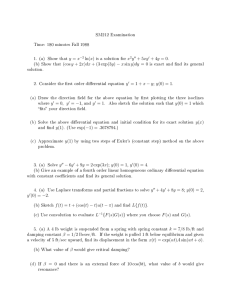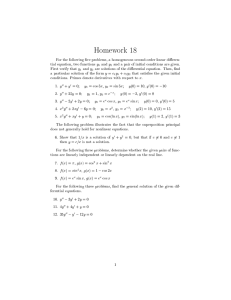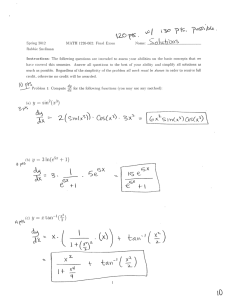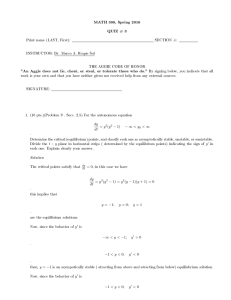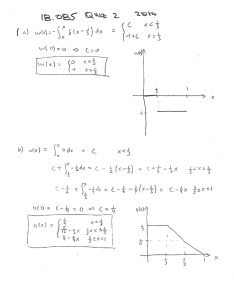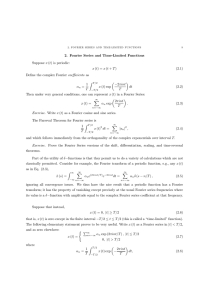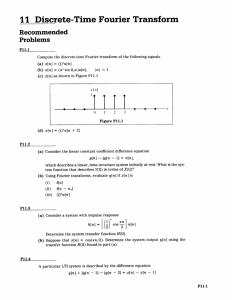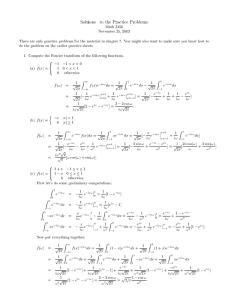Practice Problems
advertisement
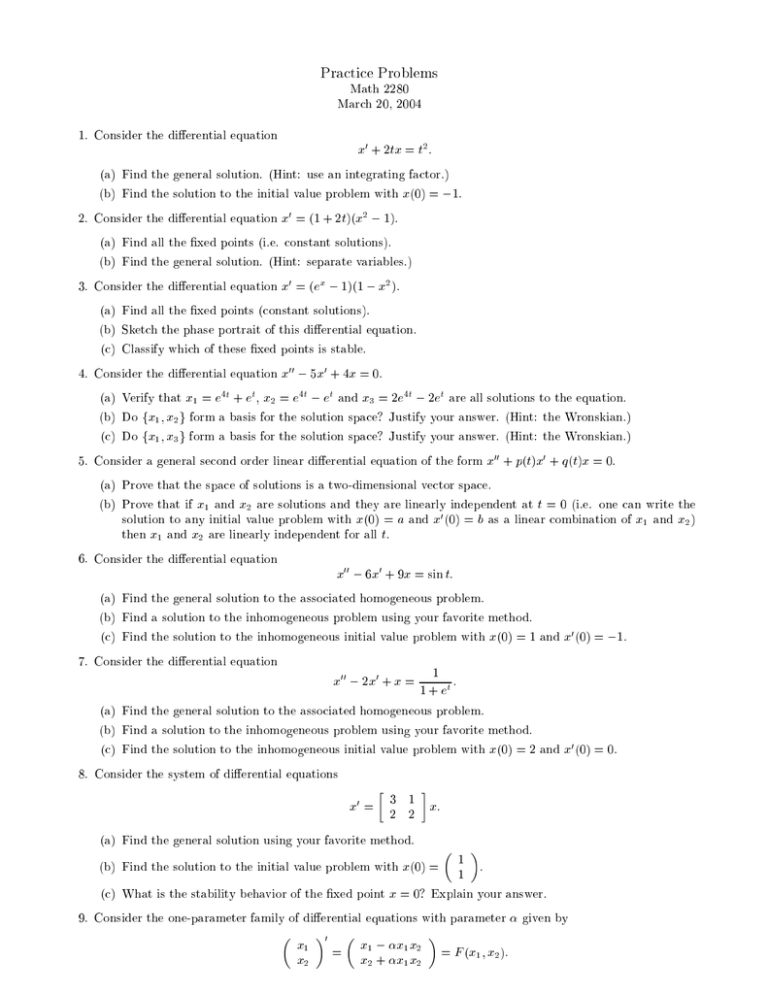
Practice Problems Math 2280 March 20, 2004 1. Consider the dierential equation 2. 3. 4. 5. x + 2tx = t2 : 0 (a) Find the general solution. (Hint: use an integrating factor.) (b) Find the solution to the initial value problem with x(0) = ?1. Consider the dierential equation x = (1 + 2t)(x2 ? 1). (a) Find all the xed points (i.e. constant solutions). (b) Find the general solution. (Hint: separate variables.) Consider the dierential equation x = (ex ? 1)(1 ? x2 ). (a) Find all the xed points (constant solutions). (b) Sketch the phase portrait of this dierential equation. (c) Classify which of these xed points is stable. Consider the dierential equation x ? 5x + 4x = 0. (a) Verify that x1 = e4t + et, x2 = e4t ? et and x3 = 2e4t ? 2et are all solutions to the equation. (b) Do fx1 ; x2 g form a basis for the solution space? Justify your answer. (Hint: the Wronskian.) (c) Do fx1 ; x3 g form a basis for the solution space? Justify your answer. (Hint: the Wronskian.) Consider a general second order linear dierential equation of the form x + p(t)x + q(t)x = 0. (a) Prove that the space of solutions is a two-dimensional vector space. (b) Prove that if x1 and x2 are solutions and they are linearly independent at t = 0 (i.e. one can write the solution to any initial value problem with x(0) = a and x (0) = b as a linear combination of x1 and x2 ) then x1 and x2 are linearly independent for all t. Consider the dierential equation x ? 6x + 9x = sin t: (a) Find the general solution to the associated homogeneous problem. (b) Find a solution to the inhomogeneous problem using your favorite method. (c) Find the solution to the inhomogeneous initial value problem with x(0) = 1 and x (0) = ?1. Consider the dierential equation 1 : x ? 2x + x = 1 + et 0 0 00 0 00 0 0 6. 00 0 0 7. 00 0 (a) Find the general solution to the associated homogeneous problem. (b) Find a solution to the inhomogeneous problem using your favorite method. (c) Find the solution to the inhomogeneous initial value problem with x(0) = 2 and x (0) = 0. 8. Consider the system of dierential equations x = 32 12 x: 0 0 (a) Find the general solution using your favorite method. 1 . 1 (c) What is the stability behavior of the xed point x = 0? Explain your answer. 9. Consider the one-parameter family of dierential equations with parameter given by (b) Find the solution to the initial value problem with x(0) = x1 x2 0 = x1 ? x1 x2 x2 + x1 x2 = F (x1 ; x2 ): (a) Verify that the only xed points of this system are (0; 0) and (?1=; 1=) for = 6 0, and only (0; 0) for = 0. (b) Linearize this system about each xed point. (c) What is the stability behavior of each xed point? Explain your answer. (d) Draw some representative phase portraits. (e) Is there a bifurcation point in ? If there is, nd it. Explain your answer. 10. Consider the one-parameter family of dierential equations with parameter given by (a) (b) (c) (d) (e) x1 x2 0 = (ex1 ? 1)( ? x2 ) (ex2 ? 1)( ? x1 ) = F (x1 ; x2 ): Verify that the only xed points of this system are (0; 0) and (; ). Linearize this system about each xed point. What is the stability behavior of each xed point? Explain your answer. Draw some representative phase portraits. Is there a bifurcation point in ? If there is, nd it. Explain your answer. 11. Let f (x) = ex2 for ? x (a) Is f an even function, an odd function, or neither? (b) Without computing them, what can you say about the Fourier coecients bk in the Fourier series for f? 12. Let f be an odd function on [?; ]. (a) What is the average value of f ? (b) What can you say about the Fourier coecients of f ? (c) Suppose that in addition f is -periodic. Can you say anything more about the Fourier series of f ? 13. For which of the PDEs listed below does the principle of superposition hold (i.e. when can you add solutions to obtain another solution)? (a) (b) (c) (d) utt = uxt utt = ux ? ut u2t = uxx utx = uxx ? utt 14. Let f and g be the 2-periodic functions dened in the interval [?; ] by f (t) = and g(t) = +t ?t ? t 0 0t ? t 0 ?1 0 t : 1 (a) Find the Fourier series for f . (b) Find the Fourier series for g. (c) Compute the derivative of f formally by dierentiating its Fourier series term by term. You should obtain the Fourier series for g. Use this series expansion to verify that f is piecewise C 1 (i.e. has one piecewise continuous derivative). The key point is that the formal derivative you compute by dierentiating the Fourier series term by term does actually converge. (d) Formally dierentiate f once more by dierentiating the Fourier series (again) term by term. Does the series you obtain converge? Explain your answer. 15. (a) Find the Fourier series expansion for the odd extension of f (t) where f (t) = t ? t2 for 0 t . (b) Find the Fourier series expansion for the even extension of f (t) where f (t) = t ? t2 for 0 t . (c) Find the solution to the boundary value problem ut = uxx for 0 x and t 0 with the initial conditions u(x; 0) = x ? x2 and boundar conditions u(0; t) = 0 = u(; t). (Hint: separate variables and expand in Fourier series.) (d) Find the solution to the boundary value problem ut = uxx for 0 x and t 0 with the initial conditions u(x; 0) = x ? x2 and coundary conditions ux(0; t) = 0 = ux (; t). (Hint: separate variables and expand in Fourier series.) 16. (a) Find the Fourier series expansion for the odd extension of f (t) where f (t) = t 0 t 2 ? t 2 t for 0 t . (b) Solve the boundary value problem utt = uxx for 0 x and t 0 with the initial conditions u(x; 0) = f (x) and boundary conditions u(0; t) = 0 = u(; t). (Hint: separate variables and expand in Fourier series.) (c) Write the solution you found in the previous part as the sum of a left-traveling wave and a right-traveling wave. 17. Consider the wave equation u(0; t) = 0 = u(1; t); @t2 u = @x2 u; where the intial velocity @t u(x; 0) is zero and the initial position is given by 8 < 0 0 x < 1=4 u(x; 0) = 1 1=4 x 3=4 : 0 3=4 < x 1: What is the smallest positive time t such that u(7=8; t) 6= 0? (Hint: use d'Alembert's solution.) 18. Solve the following heat equations. (a) ut = uxx, u(0; t) = 0 = u(; t), u(x; 0) = 2 sin(2x) ? sin(3x). (b) ut = uxx, u(0; t) = 0 = u(1; t), u(x; 0) = 1=2 ? jx ? 1=2j. (c) ut = uxx, ux(0; t) = 0 = ux(1; t), u(x; 0) = ? sin(2x) + 2 sin(x). 19. (a) Consider the heat equation @t u = @x2 u; u(0; t) = 0 = u(L; t); and dene the energy at time t as E (t) := Z L 0 u(x; 0) = f (x) u2 (x; t)dx: Show that the energy is a decreasing function in time. Does this make sense physically? (Hint: how can you characterize decreasing functions of one variable? You might want to use the equation and the boundary conditions, and integrate by parts at some point.) (b) Consider the same heat equation as in the previous part, but this time with the boundary conditions @x u(0; t) = 0 = @x (L; t): Is the energy still decreasing? Explain your answer. 20. The equation of motion for a damped vibrating string is @t2 u + k@t u = c2 @x2 u: As in the case of a free vibrating string, we will consider the case where the endpoints of the string are xed at the same height, the length of the string is L, and look for a solution of the form u(x; t) = v(x)w(t): (a) What are the ODEs which v and w satisfy? (b) What boundary conditions and/or initial conditions must v and w satisfy? (c) Can you use these boundary/initial conditions to say anything about the solutions to the ODEs?



